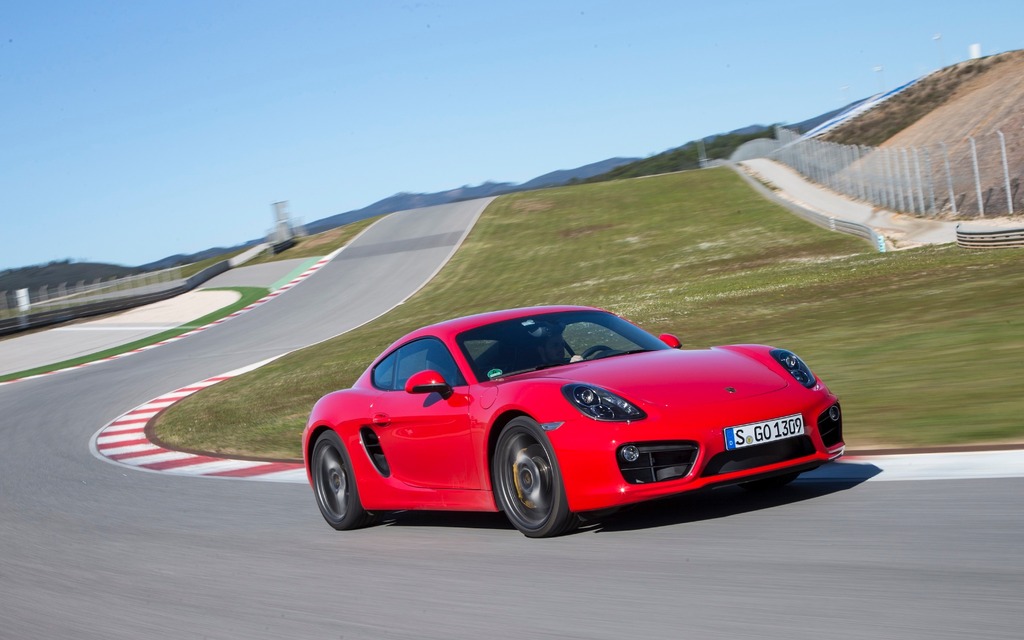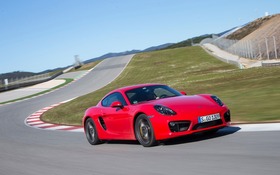2014 Porsche Cayman: Precise, balanced and dynamic

| Strong points |
|
|---|---|
| Weak points |
|
The Cayman occupies a unique spot in the Porsche “constellation.” Even though it shares several features with the Boxster, don’t jump to the conclusion that it’s a coupe version of the roadster. The truth of the matter is that it is more performance-oriented with a more rigid chassis and higher from its drivertrains. And while the 911 Carrera remains the label’s most emblematic vehicle, the Cayman offers a resolutely more modern approach with its mid-engine (2.7 litres and 275 horsepower for the Cayman and 3.4 litres and 325 horsepower for the Cayman S) that optimizes balance by centralizing the mass.
After its makeover, the Cayman is 30 kilos lighter, its wheelbase is 60 millimetres longer and its front and rear tracks are wider. At a mere 1,310 kilos, the Cayman is lightest sports car in its category. It owes its newfound lightness of being to more widespread use of aluminum, which now accounts for about 44% of the body (front end, chassis, floor and tailend of the vehicle, doors and both trunk covers). Changes made to the chassis have also helped improve static torsional rigidity by nearly 150%, static flexural rigidity by 30% and dynamic flexural rigidity by more than 70%. In fact, so rigid is the new Cayman’s chassis that you’ll think it was chiselled in a block of granite.
- Also: 2014 Porsche Cayman: A Religious Experience
- Also: Porsche Launches the new Boxster and Cayman GTS
More confident
The new Cayman exudes more confidence than its predecessor as a result of its increased size, higher-performance tires and more aggressive look. At 0.30, its drag coefficient remains excellent. On board, the Carrera GT-inspired central console stands out, as does the fact that all the accessories are controlled by distinct buttons (evidence that Porsche despises integrated telematics systems controlled by a menu selector dial).
The center colour screen is larger than before and the new Cayman’s options include Adaptive Cruise Control (ACC) and the Entry & Drive keyless entry system. The car’s larger dimensions mean that the passenger compartment is roomier too. Visibility is also improved and the interior finish is as good as on the 911 Carrera.
Track tested
During the launch in Portugal, we were able to test the Cayman S on the roads of the Algarve region and on the Circuito Internacional Algarve in Portimao. With blind turns and changes in elevation, this track was the ideal playground to judge the new Cayman S’s aptitudes. With a weight/power ratio of 4.1 kg per horsepower, the Cayman S can go from 0-100 km/hr in 4.7 seconds with the Sport Plus Package and the fantastic PDK dual-clutch gearbox. On the circuit, the Cayman S is lively, direct and precise, responding almost instantly to every command.
As for performance, the only drawback that we noticed is that the power steering doesn’t provide feedback as accurately as the previous version’s hydraulic steering, but you quickly get used to this minor shortcoming after a few laps. The brakes still perform extremely well, and although Porsche is offering optional ceramic composite brakes on the Cayman (as on its other models), they are only useful on a track.
The Cayman S’ options include a PTV system that combines the action of the limited-slip rear differential and individual brake interventions on the inside wheel to better position the car in turns. With this equipment, the Cayman S easily finds the ideal trajectory, and the conjunction of the higher-performance wheel mount and wider tracks give it excellent stability. After just a few laps on this demanding circuit, I was able to gain an excellent appreciation for the new version’s more dynamic nature. The controlled and safe setting helped us explore its performance potential.
The Cayman S was at ease on regular roads and the comfort level was unexpectedly good. Note that our test car was equipped with PASM (Porsche Active Suspension Management) that allows you to configure the chassis settings in Normal or Sport mode. Normal mode helps the car manage the irregularities of the road surprisingly well for a sports car.
See you in the spring
The new Cayman will roll into Canadian dealerships in the spring of 2013 at a starting price of $59,000 for the Cayman and $72,900 for the Cayman S. Of course, adding options will cost you more.
Speaking of which, I recommend the PDK dual-clutch gearbox paired with the sport steering wheel (also on option) – it’s a must if you want to be able to take advantage of the wheel-mounted paddle shifters. In fact, if you don’t choose the sport steering wheel, you’ll have to use the abominable buttons on the steering wheel to shift (press the front to upshift and the back to downshift). Unique to Porsche, this layout is much less efficient and user-friendly than the traditional paddle shifters adopted by all the sports car manufacturers that offer dual-clutch transmissions.
I would also opt for the PASM system, PTV and the sport exhaust (which helps you fully appreciate the roar of the engine between 4,000 and 7,500 rpm). More complete, more efficient and more striking, the Cayman S is sure to win over drivers looking for exceptional dynamics. It’s now the category benchmark for balance and consistency. In short, it’s simply superb.











